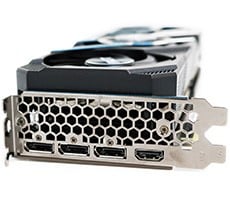ASUS A8N32 SLI Deluxe - nForce 4 SLI X16 Unleashed
With Doom 3's graphical settings configured for "high quality" mode and the screen resolution turned up to 1280X1024 and 1600X1200, the game engine and graphics rendering loads are a heavy burden for even one of the more powerful graphics processors on the market today, the GeForce 6800GT. Certainly the recently released GeForce 7800GTX would have a much easier time with this, but then again a pair of 6800GTs in parallel should offer nearly twice the performance.
|
Here we'll also have a look to see if a full X16/X16 PCI Express SLI Graphics setup has any tangible performance benefit.


Well now, we do see a distinct pattern here with our high-quality Doom 3 tests. Without AA or Aniso Filtering turned on, versus the MSI K8N Neo4 Platinum SLI, the ASUS A8N32 SLI and its dual X16 PEG slots takes a more significant 9% lead at 1280X1024 and approximately 4% at 1600X1200. Again this is without AA and AF turned on. Enable AA and AF, and the two boards are right on top of each other, with the A8N32 SLI Deluxe scoring a few extra frames at 1280 res. So it seems as if the more GPU bound we are, the less of a lead the new nForce4 SLI X16 chipset has, but as frame rates increase, dual X16 PCI Express graphics has its advantages. We asked NVIDIA about the results we were seeing, for a more complete explanation and this is what we were told.
From Nick Stam, Director, Tech Marketing - NVIDIA:
1) The higher frame rates obtained at 1x/1x (or even at lower resolution) actually requires more data to be exchanged between the two GPU cards across PCIe per unit time (more frames per second means the cards must exchange data more frequently). Resolution variations actually don't have as much impact across PCIe as the increased frame rates do in the GPU-GPU exchanges over PCIe. While much data does exchange through the SLI bridge connector, there is still some data that goes across PCIe between GPUs.
2) With higher frame rates, the CPUs can now pump more data across PCIe to the GPUs.
Future scenarios with lots more geometry being passed to GPUs, a lot more textures, SLI-AA, and so on, will see more improvements over time.
Thanks very much for the detail Nick. This is solid insight into the potential inherent advantages of the chipset.






